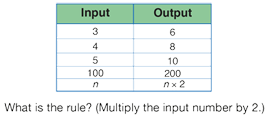Students explore number patterns. They make data tables to analyze how number patterns grow. They write rules and algebraic formulas to describe the growth and make predictions.
Content in this Lesson
- Identifying and finding multiples of numbers [E2].
- Identifying and describing number patterns [E3].
- Using variables in formulas to represent number patterns and make predictions [E4].
- Finding a strategy [MPE2].
- Checking a solution for reasonableness [MPE3].
- Explaining thinking [MPE5].
Daily Practice and Problems G–J
Assessment in this Lesson
| Assessment | Expectation Assessed | Math Practices Expectation Assessed |
|---|---|---|
|
Growth Patterns on Planet Gzorp |
|
|
|
More Patterns from Gzorp |
|
|














